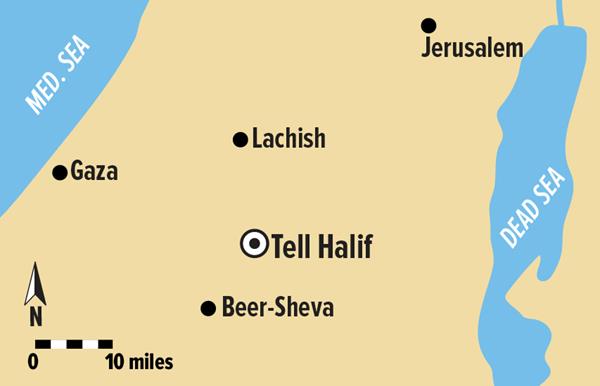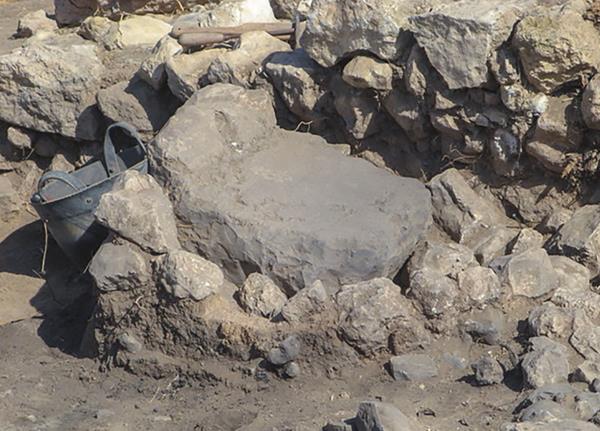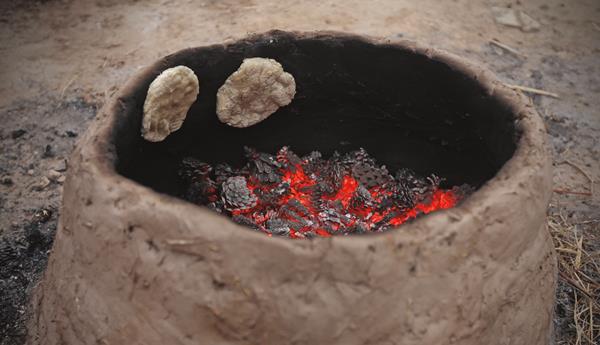Baking Bread in Ancient Judah
059

I am happy to see that people are once again interested in the daily lives of the ancient Israelites. Archaeologists and biblical scholars alike are shifting their attention from the monumental to the mundane. In other words, the stage where the ordinary is lived out day after day is the home, not the temples, palaces, and fortifications. Thus, it is the home that needs to be further explored.
One archaeological excavation that has focused on households and daily life since 1992 is Tell Halif. The goal of the excavations at Halif is to further understand daily life in Judah’s Iron IIB period (eighth century B.C.E.). Several dwellings at Halif have been excavated, and the material recovered helps archaeologists and biblical scholars alike better understand ancient Judah’s cultural context.
Approximately 1,600 feet above sea level, Tell Halif is a 10–12-acre mound located on the southern edge of the Shephelah, in a liminal zone between the Shephelah and the Negev to its south. Beer-Sheva is about 12 miles southwest of Halif. In 1976 the Lahav Research Project (named after the Kibbutz located at the base of the tell) was initiated to explore Halif. The site has been excavated from 1976 to 1980 and 1983 to 1989 by Joe D. Seger of Mississippi State University; from 1992 to 1999 by Paul F. Jacobs of Mississippi State University and Oded Borowski of Emory University; and from 2007 to 2009 and 2014 to 2016 060by Borowski. These excavations identified remains ranging from the Chalcolithic period and Early Bronze Age I (3500–3200 B.C.E.) through the Roman and Byzantine periods (200–600 C.E.).
During the eighth century B.C.E., Halif was a small fortified town within the Kingdom of Judah. Halif’s archaeological record, along with textual sources, suggest that it was one of the many towns destroyed by the Neo-Assyrian King Sennacherib in 701 B.C.E. during his march from Philistia to Lachish and Jerusalem when he suppressed the rebellion led by King Hezekiah of Judah. Textual sources that document Sennacherib’s campaign into the Levant in general and Judah in particular include the Hebrew Bible; for example, 2 Kings 18:13 says, “In the fourteenth year of King Hezekiah’s reign, King Sennacherib of Assyria attacked and captured all the fortified towns of Judah.”
The Prism of Sennacherib also highlights Sennacherib’s campaign against Judah, claiming, “As to Hezekiah, the Jew, he did not submit to my yoke, I laid siege to 46 of his (Hezekiah’s) strong cities, walled forts and to the countless small villages in their vicinity, and conquered [them] by means of well-stamped [earth-]ramps, and battering-rams brought [thus] near [to the walls] [combined with] the attack by foot soldiers, [using] mines, breeches as well as sapper work.”

Archaeological surveys show a sharp decline in settlements in the Shephelah between the eighth and seventh centuries B.C.E. The evidence suggests that Sennacherib’s campaign into Judah is the reason for this decline. In the eighth century, there were 289 sites covering 1,029 acres. Contrast that with 85 sites covering 343 acres in the seventh century.1 The eighth-century town of Tell Halif was one of the many settlements destroyed by the Neo-Assyrian campaign. Evidence of Sennacherib’s destruction of Halif includes the remains of destroyed houses covered with a thick layer of ash; mudbricks calcified by hot fire; carbonized organic material; and the remains of military weapons, such as arrowheads and sling stones.
Household archaeology helps us focus on the daily life of the average Israelite. There are three main research aspects within household archaeology: material, social, and behavioral. The material aspect consists of the physical dwelling units, secondary structures, features, areas where household activities took place, and the household’s physical possessions. The social aspect includes the members of the household and their relationship to each other, and the behavioral aspect studies the activities the household members performed.
Houses excavated from Israel’s Iron Age (c. 1200–586 B.C.E.) have a similar plan. Often called a “four-room” or “pillared” house, the typical house had two floors and a flat roof. The first floor had a room in the back running the width of the house (the “broad room”) with one to three rooms running 061perpendicular to it (“long rooms”). Pillars made of stone or wood segregated spaces on the first floor and supported the second floor. Some scholars debate whether the central long room was roofed or served as an open courtyard. Houses likely had a shared open work space (a courtyard or a forecourt) in front of the house. Ranging in size depending on needs and location, houses were multifunctional with several household activities taking place in the limited space depending on the season.

Determining the activities and behaviors in which a household engaged depends on the excavation of the material aspect. By recognizing areas of activity within the dwelling and its surrounding environment, reasonable inferences can be drawn. Activity areas can be determined by carefully mapping an area and identifying types of artifacts, their arrangement, their quantity in a given area, and their location.2 For example, if a cluster of cooking pots is found near an oven inside the dwelling, it can be safely assumed that this was a food preparation area.

062
Several eighth-century four-room houses have been excavated at Tell Halif. They share outer walls with each other and are built using the city’s casemate wall fortifications as part of the broad room of the houses. Unfortunately, the back ends of several houses have eroded because of their proximity to the tell’s western edge.

One house (called the A8 House) has two long rooms with one broad room at its back. The broad room was built into the fortification wall, and most of it has eroded down the slope of the tell. I believe there was a second story supported by large stone pillars, which also helped segregate space for household activities on the ground floor. The A8 House shares its main walls with other houses to its north and south. An open work space lies to its east. The floors were made of beaten earth with the exception of one segment of cobblestone floor.
I have identified four rooms in the house: Rooms 1 and 2 are the long rooms, with Room 3 as a small room in the back of Room 2. It’s unclear if the broad room (Room 4) would have been a singular room or divided into two, because most of the room has eroded. If we consider the open work space in the front of the house as an additional room, it would be classified as Room 5. Here I will concentrate on the main living areas, designated as Rooms 1 and 2, and the daily activities that occurred there.

Separated by two stone pillars, Rooms 1 and 2 served as the main living space. Certain areas within 063these rooms were dedicated to specific activities.

Room 1 has a grinding installation with the grinding stone inside. The installation is made of a semicircular fieldstone wall built against the house’s main northern wall. Its interior consists of two layers: mudbrick material topped by small fieldstones with the grinding stone on top. Another semicircular installation in the far western end of the room is made of one course of small fieldstones. The fill inside this installation was primarily debris, which makes its use difficult to identify.
The beaten earth floor surrounding both installations contained a large quantity of pottery (mostly storage jars), carbonized organic remains, and a cosmetic palette. In the northeastern part of the room a number of astragali (ankle bones of an unknown animal) was found on top of a very dark ash patch, as well as a cooking pot in a pit.
Room 2 contained a crushed oven with patches of ash and the fragments of a cooking pot. Other remains found on the floor include an oil lamp, 19 loom weights, and three loom weight fragments.
All clues point to food preparation being the main activity that occurred in the living space. The grinding installation is our strongest clue into what food production activity occurred here: grinding grain into flour. It’s been estimated that the ancient Israelites and Judahites obtained 50 percent of their daily caloric intake from cereals. Thus the preparation of flour was a significant and time-consuming household activity.3
The numerous storage vessels concentrated near the grinding installation are related to the flour production and storage. The semicircular installation located nearby could also have been used as a storage bin. If the microanalysis report indicates that the carbonized organic remains from the floor are indeed grain, their presence near the grinding installation and the storage jars would suggest that grain was stored in the jars and processed in the grinding installation into flour. The few random oven fragments, cooking pot, and burnt patches in the eastern side of Room 1 could also indicate that additional food preparation activities occurred here.
Food preparation seems to have taken place in Room 2 as well. The oven fragments along with the ash patches and cooking potsherds all indicate that this space was also used for cooking.
Ovens found in the archaeological record are usually not well preserved, so it is difficult to determine precisely what they looked like. One complete tenth-century B.C.E. clay oven was excavated at Tel Rehov in Israel. Standing about 2 feet tall, the oven comes from a dwelling that the 064excavators interpret as an inner courtyard. Like other contemporary ovens, it has a conical cylinder shape. However, unlike the other ovens, its flue was preserved. The oven’s exterior was lined with large, closely packed potsherds set in clay, which helped insulate the oven.4
Ethnographic studies in the Middle East provide several oven types, some of which may be descendants of ancient ovens. The type of oven that most resembles those found in archaeological excavations in Israel and Judah is the tannur. A modern tannur is a cylindrical clay oven that stands about 3 feet high. It has two openings: one large opening at the top to access the interior of the oven for baking and one at the bottom that serves as a flue. The tannur is heated by starting a fire on the floor inside. A baker then slaps dough onto the interior walls to bake.
In Halif’s eighth-century levels, a total of five bread ovens and one probable hearth have been found. Most of these ovens and the hearth can be clearly set within households.
The remains of ovens in Iron Age Israel and Judah are similarly found both in indoor and outdoor central spaces and are markers of a living room-type space. Ethnographic and ethnoarchaeological studies in the Middle East indicate that ovens were located in the central living room space within the house. Not only were the ovens used to prepare food, but they also served as the focal gathering point for the household during the cold winter months.
Furthermore, in rural villages in western Iran, hearths were usually located near the center of the room in the house, with no special provision made for the escape of smoke. As a result, the roof beams and ceiling of the house were quite blackened.5 Iron Age houses probably had only small windows on the first floor to regulate the house’s temperature and to prevent intruders. During the cold winter months, smoke from the indoor oven would have escaped through the few, small windows, a point the Hebrew Bible illustrates: “Therefore they [Ephraim] shall be like … smoke from a window” (Hosea 13:3).
Various activities occurred in the limited household space. The numerous loom weights found next to each other in Room 2 indicate that a small loom once occupied this room and that weaving activities also were conducted in the living room.
Gender archaeology (research that considers the relationships of women and men to the social, economic, political, and ideological structures of particular societies) also helps us understand the daily lives of average ancient Israelite women, who are often ignored within the biblical text. Daily, repetitious activities can tell us a lot about what our society values and devalues. The same idea can be applied to past societies. The everyday activities of ancient societies leave us clues about their values and attitudes, including those related to identity, class, and gender. The repetition of activities, postures, gestures, dress, and language make gender visible in the archaeological record, while the place in which these activities occurred serves as the stage.
For instance, the cosmetic palette found near the grinding installation in the A8 House likely indicates which household members ground grain. Women used cosmetic palettes to grind kohl for eye-paint to enhance their beauty. Since the female reproductive role was a major concern for the ancient Israelite household, biological factors such as menstruation, pregnancy, birth, lactation, and weaning obviously fell under the female domain. Consequently, these factors dictated that the women were obliged to conduct household tasks within or near the dwelling.
The centralized location of ovens enabled women to conduct other household chores while preparing food. It also allowed them to share resources with other women in their neighborhood or village, such as the oven itself and dung used for fuel. In turn, this encouraged social relationships and cohesion among the group (Leviticus 26:26). Thus, it is likely that the female household members controlled the household’s food preparation activities and dominated the A8 House’s main living space.
Granted, the main function of a house was to provide shelter for the household’s members and animals, but houses were much more than that. They were just as much a workplace as a dwelling place. The houses in the Halif neighborhood, including the A8 House, are similar in that they all contained domestic assemblages related to storage, production, food preparation, and consumption. However, some houses had unique features and assemblages that lead us to consider whether certain houses had functions distinct from the rest of the neighborhood.
The permanent grinding installation coupled with the numerous storage jars and carbonized remains suggest that food preparation on a fairly large scale occurred in the A8 House. Perhaps this house served as some sort of shared flour production facility within the neighborhood, a shared facility dominated by women.
This begs the question: Did Halif households have specific roles in their neighborhood? Does Halif provide evidence of the beginning of craft and trade specialization within a community? Some of our preliminary research suggests this is the case, and we look forward to investigating this theory further.
I am happy to see that people are once again interested in the daily lives of the ancient Israelites. Archaeologists and biblical scholars alike are shifting their attention from the monumental to the mundane. In other words, the stage where the ordinary is lived out day after day is the home, not the temples, palaces, and fortifications. Thus, it is the home that needs to be further explored. One archaeological excavation that has focused on households and daily life since 1992 is Tell Halif. The goal of the excavations at Halif is to further understand daily life in Judah’s […]
You have already read your free article for this month. Please join the BAS Library or become an All Access member of BAS to gain full access to this article and so much more.
Already a library member? Log in here.
Institution user? Log in with your IP address or Username
Endnotes
1.
Yehuda Dagan, “Results of the Survey: Settlement Patterns in the Lachish Regions,” in David Ussishkin, ed., The Renewed Archaeological Excavations at Lachish (1973-1994), vol. 5, Monograph Series of the Institute of Archaeology of Tel Aviv University 22 (Tel Aviv: Emery and Claire Yass Publications in Archaeology, 2004), p. 2683.
2. James W. Hardin, Households and the Use of Domestic Space at Iron II Tell Halif: An Archaeology of Destruction, Reports of the Lahav Research Project at Tell Halif, Israel, vol. 2 (Winona Lake: Eisenbrauns, 2010), p. 34; Cynthia Shafer-Elliott, Food in Ancient Judah: Domestic Cooking in the Time of the Hebrew Bible (Sheffi eld: Equinox, 2012), pp. 12-14. Cynthia Shafer-Elliott, “Gender Archaeology,” in Cynthia Shafer-Elliott, ed., The Five Minute Archaeologist in the Southern Levant (Sheffield: Equinox, 2016), pp. 161-164; James W. Hardin, “Understanding Domestic Space: An Example from Iron Age Tell Halif,” Near Eastern Archaeology 67 (2004), p. 74.
3.
Peter Altmann, “Diet, Bronze and Iron Age,” in Daniel Master, ed., The Oxford Encyclopedia of the Bible and Archaeology, vol. 1 (Oxford: Oxford Univ. Press, 2013), p. 288.
